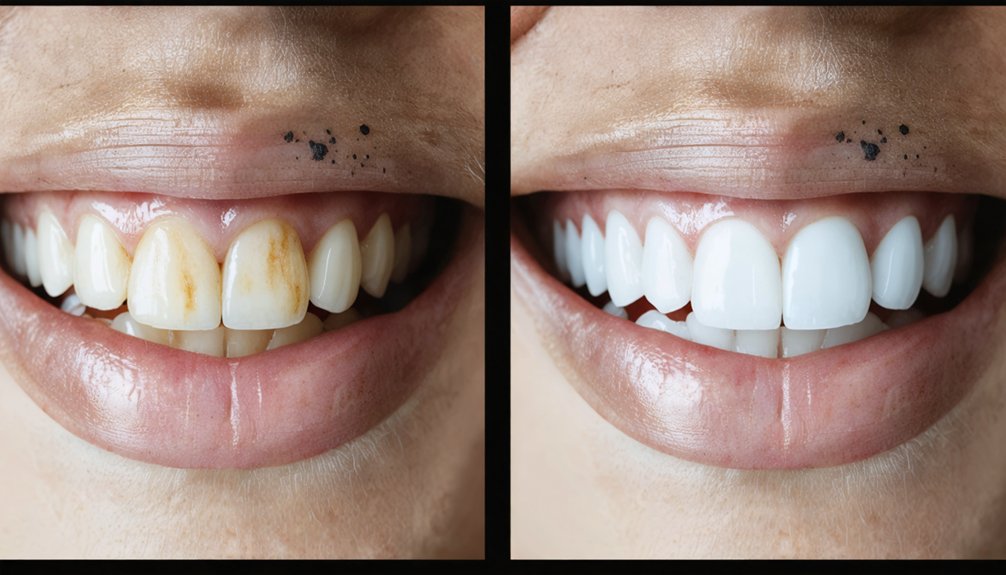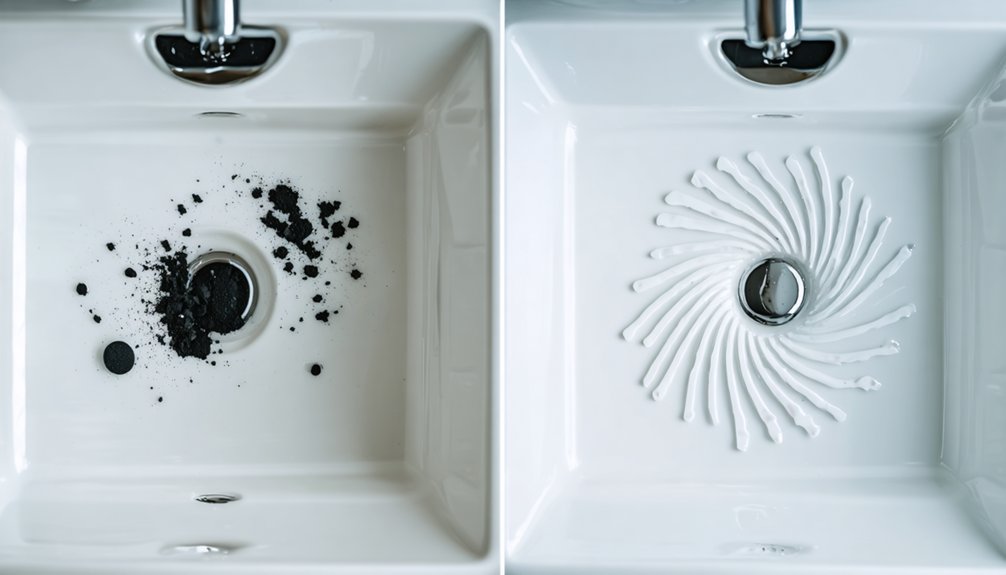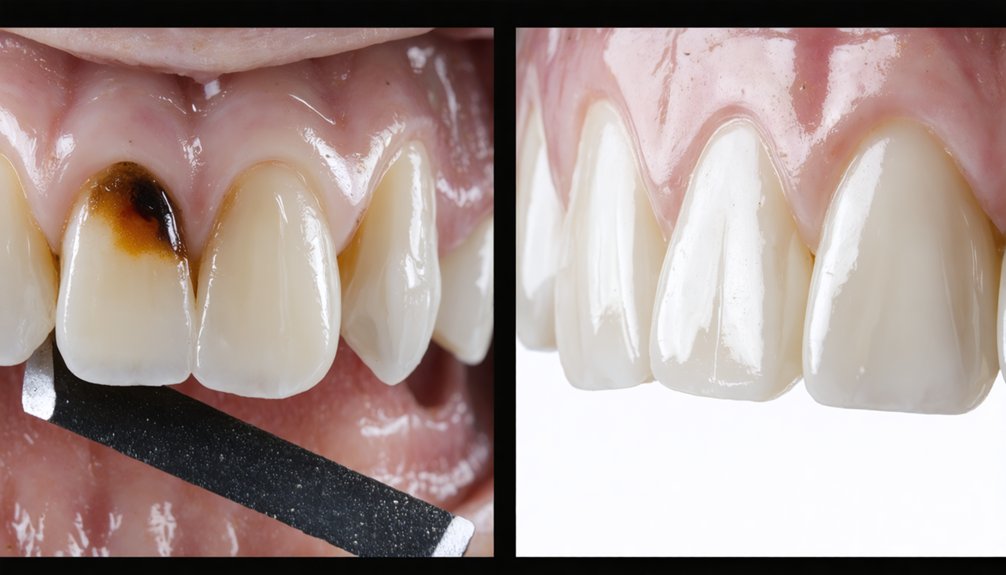You’ll find that charcoal teeth whitening strips offer limited effectiveness, primarily removing surface stains through mild abrasion rather than deep whitening. Clinical studies show their results fall short compared to peroxide-based alternatives, while raising concerns about potential enamel damage from abrasive particles. Despite marketing claims, dental professionals warn that continuous use may lead to sensitivity and irreversible enamel wear. Understanding the science behind these findings reveals important considerations for your oral health.
Key Takeaways
- Charcoal strips only remove surface stains through adsorption, with no effect on deeper tooth discoloration or internal tooth color.
- Laboratory testing reveals no significant tooth color improvement after extended use of charcoal whitening products.
- Results are comparable to regular fluoride toothpaste but less effective than peroxide-based treatments for whitening teeth.
- User experiences show modest results with temporary stain removal, requiring repeated applications for minimal visible improvements.
- Safety concerns include potential enamel wear from abrasive properties and lack of clinical validation for long-term use.
Understanding the Science Behind Charcoal Whitening
While activated charcoal has gained popularity as a teeth whitening agent, its mechanism differs fundamentally from traditional bleaching methods. Unlike peroxide-based whiteners that chemically break down stains, charcoal works through an adsorption mechanism where surface stains physically bind to its highly porous structure.
You’ll find that activated charcoal’s effectiveness stems from its nanocrystalline structure and extensive surface area, which enables it to trap and remove external stains from your teeth’s enamel.
However, it’s essential to understand that this stain removal process only targets extrinsic discoloration – the surface stains from substances like coffee or wine. The charcoal can’t penetrate your enamel or alter internal tooth coloring through chemical means, limiting its whitening potential to superficial stain removal. Regular use of activated charcoal products may cause tooth enamel erosion due to their abrasive nature. The growing trend in Round Rock, Texas has led many consumers to try these products despite limited scientific evidence supporting their effectiveness.
Clinical Evidence on Whitening Performance
Scientific research challenges the popular beliefs surrounding charcoal-based teeth whitening products.
Clinical trials consistently show that charcoal strips and other charcoal-based whitening methods produce only minor effects comparable to regular fluoride toothpaste. These results fall considerably short of the whitening power achieved with carbamide peroxide treatments.
Research shows charcoal whitening products work about as well as regular toothpaste, falling far behind proven peroxide-based treatments.
Despite widespread consumer misconceptions fueled by marketing influence and social media, the evidence doesn’t support charcoal’s effectiveness for tooth whitening. The abrasive texture concerns raised by dental professionals highlight potential risks to tooth enamel with prolonged use. Professional whitening systems using hydrogen peroxide concentrations of 25-35% deliver immediate visible results.
Randomized controlled studies reveal that patients report lower satisfaction with charcoal products compared to peroxide-based alternatives.
While charcoal may initially help reduce surface stains, laboratory testing indicates no considerable improvement after extended use.
The research emphasizes that you’ll achieve better whitening results by choosing dentist-approved peroxide treatments rather than charcoal-based products.
Safety Concerns and Dental Health Impact
You’ll need to contemplate the significant enamel wear risks that charcoal whitening strips pose, as their abrasive properties can permanently damage your tooth’s protective outer layer.
The strips’ harsh texture often leads to increased gum sensitivity and inflammation, particularly when used frequently or with excessive pressure. Users may notice gray or black specks remaining on their teeth and gums after use.
These dental health impacts are compounded by the fact that most charcoal-based products lack protective ingredients like fluoride, leaving your teeth more vulnerable to decay and sensitivity issues. Additionally, according to leading dental associations, charcoal whitening strips have not received proper clinical validation through long-term research studies.
Enamel Wear Risks
Although charcoal teeth whitening strips have gained popularity, their abrasive properties pose significant risks to dental enamel integrity.
The continuous use of these strips can lead to accelerated enamel degradation, exposing the underlying dentin and increasing your vulnerability to dental problems. You’ll notice a sensitivity increase when consuming hot or cold foods as the protective enamel layer thins. Professional treatments using hydrogen peroxide bleaching provide safer and more controlled whitening results. Daily tooth brushing habits, combined with proper oral hygiene practices, are more effective at maintaining white teeth than charcoal-based products.
What’s particularly concerning is that once your enamel wears away, it can’t regenerate. This irreversible damage makes your teeth more susceptible to bacterial adhesion and decay.
The roughened surface created by charcoal particles can trap bacteria, leading to long-term oral health complications. Given these risks, you should consider safer, dentist-approved whitening alternatives that won’t compromise your enamel’s protective function or your overall dental health.
Gum Sensitivity Issues
Beyond enamel erosion, charcoal teeth whitening strips present significant risks to gum health and sensitivity.
When these strips make contact with your gums, the bleaching agents and abrasive charcoal particles can trigger inflammation, redness, and discomfort. Extended contact times of twenty minutes per application can intensify gum irritation. You’ll notice increased gum irritation particularly if you have pre-existing gum recession or apply the strips incorrectly.
Immediate discontinuation of whitening treatments is essential if any gum pain develops.
Prolonged exposure to these whitening agents can lead to tissue damage, bleeding, and heightened sensitivity that affects your daily activities.
You’re also at greater risk of bacterial infections when gums become irritated and compromised.
To minimize these risks, you’ll need to guarantee proper strip placement, use products with lower concentrations of active ingredients, and monitor your gums for early signs of irritation.
If sensitivity occurs, consider using salt water rinses or over-the-counter gels for relief.
Comparing Charcoal vs. Peroxide-Based Options
When you’re choosing between charcoal and peroxide-based whitening strips, you’ll find significant differences in their whitening effectiveness and mechanisms of action.
While peroxide strips offer clinically proven, deeper whitening through chemical oxidation of stains, charcoal strips primarily work through surface-level stain removal via adsorption and mild abrasion.
You’ll need to weigh these efficacy differences against safety considerations, as peroxide strips may cause temporary tooth sensitivity but have well-documented long-term safety.
In contrast, charcoal strips pose potential risks of enamel abrasion with less established safety data.
Whitening Power Differences
While both charcoal and peroxide-based teeth whitening strips aim to brighten your smile, their mechanisms of action differ significantly regarding whitening power and effectiveness.
Peroxide-based strips deliver superior results through chemical bleaching that penetrates your enamel, breaking down both surface and intrinsic stains. You’ll notice significant whitening within 1-2 weeks of use.
In contrast, charcoal efficacy relies primarily on physical absorption and mild abrasion for stain removal, offering only low to moderate results that are often temporary.
When you’re considering whitening options, understand that charcoal’s surface-level action can’t match peroxide’s deeper whitening capabilities.
Studies consistently show that peroxide-based treatments produce more predictable, measurable improvements under clinical conditions, while charcoal’s effects tend to fade once you discontinue use.
Safety Profile Comparison
The safety considerations between charcoal and peroxide-based whitening strips present notable contrasts in their impact on dental health.
While peroxide effectiveness has been well-documented through regulated testing, charcoal ingredients pose significant risks due to their abrasive nature and lack of standardization.
- You’ll find peroxide-based strips typically contain fluoride and protective agents, safeguarding your enamel during the whitening process.
- Your enamel faces potential erosion with charcoal products, which can expose darker dentin underneath.
- You’re less likely to experience permanent damage with peroxide strips when following instructions, whereas charcoal’s abrasiveness may cause lasting harm.
- Your gums might show temporary sensitivity with peroxide treatments, but charcoal residue can lead to excessive brushing and tissue damage.
Choose peroxide-based options for a scientifically-validated approach that prioritizes your dental health while achieving whitening goals.
Real-World Results and User Experience

How do charcoal teeth whitening strips perform in real-world settings? User testimonials indicate that results tend to be modest, with most people experiencing superficial stain removal rather than dramatic whitening.
While these strips typically cause less sensitivity than peroxide-based alternatives, they may require longer or repeated applications to achieve noticeable results.
Whitening expectations should be tempered when using charcoal-based products. You’ll likely see minimal to slight improvements in tooth color, particularly effective for removing surface coffee stains.
Expect modest results from charcoal whitening products – they work best for removing surface stains rather than deep tooth discoloration.
The absence of peroxide limits their whitening potential, though this gentler approach appeals to those with sensitive teeth. For maintenance purposes, charcoal strips can serve as a mild whitening option, but if you’re seeking significant color changes, peroxide-based products generally deliver better results.
Professional Dental Perspectives
Dental professionals maintain significant reservations about charcoal teeth whitening strips, citing limited clinical evidence for their efficacy and potential risks to enamel integrity.
Professional recommendations from major dental associations consistently emphasize caution, with expert opinions highlighting the lack of clinical support for charcoal-based whitening products.
- You’ll find no endorsements from leading dental organizations like the ADA for charcoal whitening products.
- Your dentist will likely advise against daily use due to documented enamel abrasion risks.
- You should limit applications to twice weekly maximum if you choose to use these products.
- You’ll need to maintain regular fluoride use to protect your enamel from potential damage.
If you’re considering charcoal strips, it’s essential to consult your dental professional first, especially if you have existing dental work or sensitivity issues.
Current Research Status and Future Directions

While scientific interest in charcoal teeth whitening strips continues to grow, current research reveals significant limitations in both methodology and clinical evidence.
You’ll find most studies lack long-term follow-up data, standardized measurements, and large sample sizes. This creates challenges in establishing definitive conclusions about effectiveness and safety.
Future research needs to address several critical gaps, including standardized testing protocols, thorough safety evaluations, and comparative analyses with traditional whitening methods.
Consumer education remains essential as research shows charcoal strips primarily work through surface stain removal rather than deep whitening.
You should note that while these products may appeal to those seeking natural alternatives, current evidence suggests they’re less effective than peroxide-based options and carry potential risks of enamel abrasion with repeated use.
Frequently Asked Questions
Can Charcoal Whitening Strips Stain Clothing or Bathroom Surfaces?
Black as night, charcoal strips can seriously stain your clothes and bathroom. For staining prevention, use protective barriers during application. Follow immediate cleanup tips like rinsing surfaces thoroughly after use.
How Soon After Dental Work Can I Use Charcoal Whitening Strips?
You’ll need to wait 1-2 weeks after dental work for post dental care. Don’t use charcoal whitening strips until your dentist confirms proper whitening timing, as enamel needs recovery time.
Do Charcoal Strips Work Differently on Crowns or Veneers?
You won’t achieve charcoal effectiveness on dental restorations since crowns and veneers are non-porous. While charcoal strips can whiten natural teeth, they can’t penetrate or change the color of restorations.
Are Charcoal Whitening Strips Safe During Pregnancy or Breastfeeding?
You shouldn’t use charcoal whitening strips during pregnancy or breastfeeding due to safety concerns. There’s no scientific evidence confirming their safety, and dental experts recommend waiting until after these periods to pursue whitening treatments.
Can Charcoal Strips Be Used Together With Other Whitening Products?
You shouldn’t combine charcoal strips with other whitening products, as these interactions can damage your enamel. If you’re considering combining whitening methods, consult your dentist for personalized guidance first.
References
- https://pmc.ncbi.nlm.nih.gov/articles/PMC8404563/
- https://www.todaysrdh.com/what-the-research-shows-regarding-the-efficacy-of-dental-whitening-options/
- https://pmc.ncbi.nlm.nih.gov/articles/PMC10266434/
- https://www.soladentalspa.com/blog/are-teeth-whitening-strips-effective
- https://www.nature.com/articles/s41405-024-00227-2
- https://www.frontiersin.org/journals/dental-medicine/articles/10.3389/fdmed.2021.687507/full
- https://drellisdentistry.com/blog/charcoal-teeth-whitening-trend/
- https://tooth-doctor.com/does-charcoal-teeth-whitening-work/
- https://pmc.ncbi.nlm.nih.gov/articles/PMC8095700/
- https://pmc.ncbi.nlm.nih.gov/articles/PMC10351494/



